Vendor Management and Infrastructure Analysis Report - INF80042
VerifiedAdded on 2023/06/04
|13
|3323
|448
Report
AI Summary
This report examines vendor management within the context of infrastructure, using Microsoft as a case study. It explores key aspects of vendor management, including vendor selection criteria, the vendor management process, and relationship-building strategies. The report details different approaches to vendor management, such as centralized, decentralized, and hybrid models, emphasizing the importance of clear communication and adherence to established guidelines. It also addresses issues in vendor management, such as unresponsiveness, cultural differences, and lack of transparency, offering solutions to overcome these challenges. Furthermore, the report discusses vendor management trends, including standardization, consolidation, and the use of robotic process automation, highlighting the importance of long-term contracts and relationship management. The report concludes by emphasizing the significance of effective communication, risk management, and the implementation of best practices to navigate the complexities of vendor management and ensure successful outcomes. This analysis is crucial for understanding how organizations can effectively manage their vendors to improve service quality, control costs, and mitigate risks within their infrastructure management frameworks.
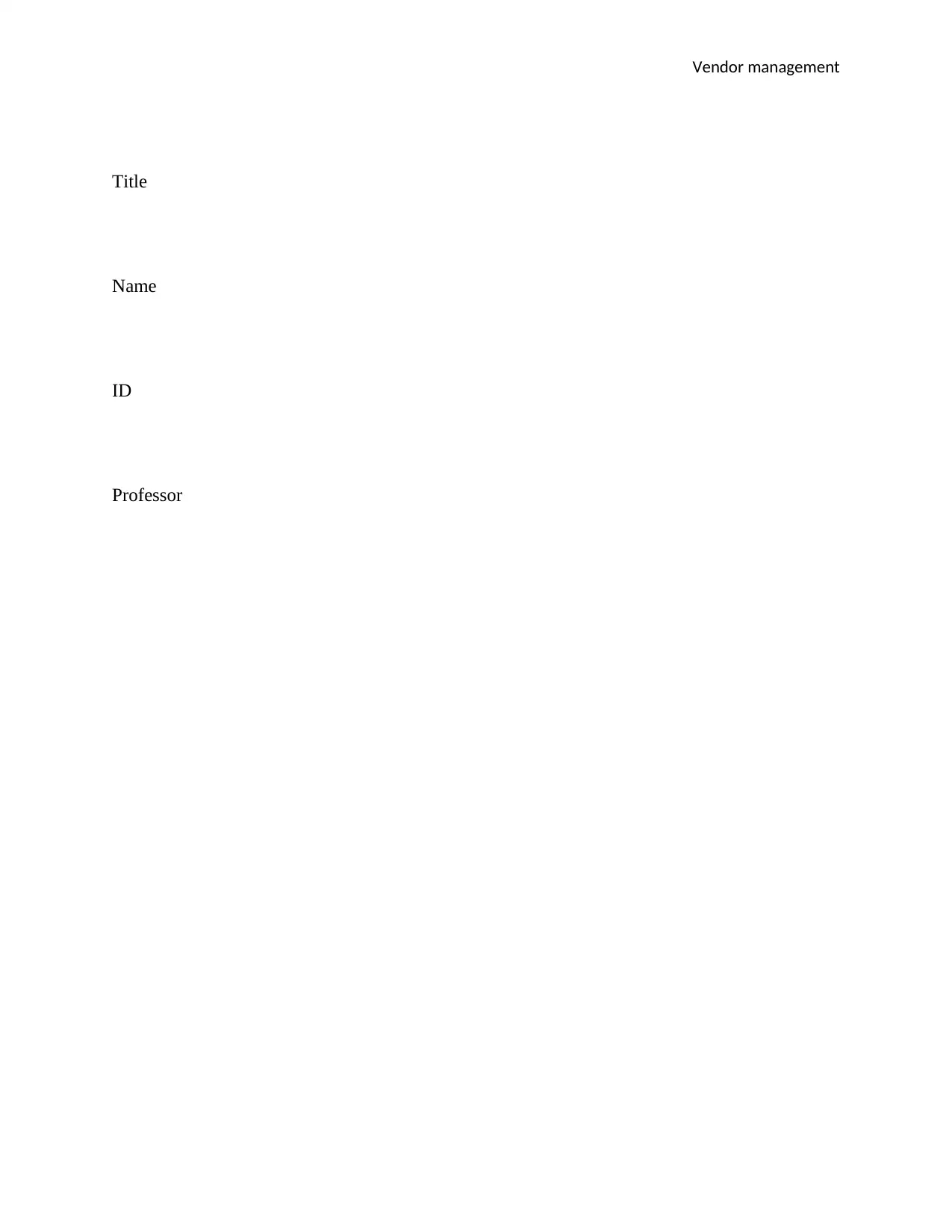
Vendor management
Title
Name
ID
Professor
Title
Name
ID
Professor
Paraphrase This Document
Need a fresh take? Get an instant paraphrase of this document with our AI Paraphraser
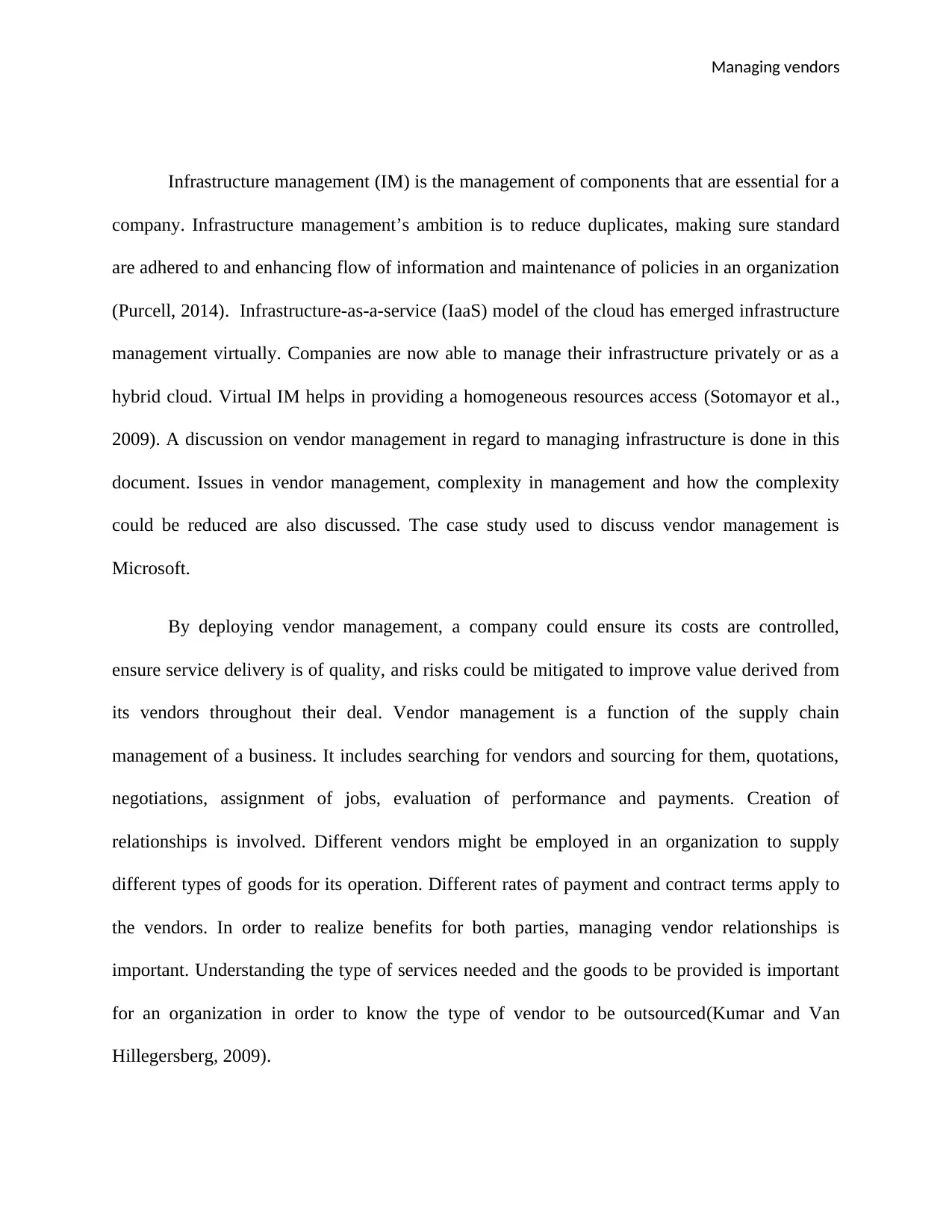
Managing vendors
Infrastructure management (IM) is the management of components that are essential for a
company. Infrastructure management’s ambition is to reduce duplicates, making sure standard
are adhered to and enhancing flow of information and maintenance of policies in an organization
(Purcell, 2014). Infrastructure-as-a-service (IaaS) model of the cloud has emerged infrastructure
management virtually. Companies are now able to manage their infrastructure privately or as a
hybrid cloud. Virtual IM helps in providing a homogeneous resources access (Sotomayor et al.,
2009). A discussion on vendor management in regard to managing infrastructure is done in this
document. Issues in vendor management, complexity in management and how the complexity
could be reduced are also discussed. The case study used to discuss vendor management is
Microsoft.
By deploying vendor management, a company could ensure its costs are controlled,
ensure service delivery is of quality, and risks could be mitigated to improve value derived from
its vendors throughout their deal. Vendor management is a function of the supply chain
management of a business. It includes searching for vendors and sourcing for them, quotations,
negotiations, assignment of jobs, evaluation of performance and payments. Creation of
relationships is involved. Different vendors might be employed in an organization to supply
different types of goods for its operation. Different rates of payment and contract terms apply to
the vendors. In order to realize benefits for both parties, managing vendor relationships is
important. Understanding the type of services needed and the goods to be provided is important
for an organization in order to know the type of vendor to be outsourced(Kumar and Van
Hillegersberg, 2009).
Infrastructure management (IM) is the management of components that are essential for a
company. Infrastructure management’s ambition is to reduce duplicates, making sure standard
are adhered to and enhancing flow of information and maintenance of policies in an organization
(Purcell, 2014). Infrastructure-as-a-service (IaaS) model of the cloud has emerged infrastructure
management virtually. Companies are now able to manage their infrastructure privately or as a
hybrid cloud. Virtual IM helps in providing a homogeneous resources access (Sotomayor et al.,
2009). A discussion on vendor management in regard to managing infrastructure is done in this
document. Issues in vendor management, complexity in management and how the complexity
could be reduced are also discussed. The case study used to discuss vendor management is
Microsoft.
By deploying vendor management, a company could ensure its costs are controlled,
ensure service delivery is of quality, and risks could be mitigated to improve value derived from
its vendors throughout their deal. Vendor management is a function of the supply chain
management of a business. It includes searching for vendors and sourcing for them, quotations,
negotiations, assignment of jobs, evaluation of performance and payments. Creation of
relationships is involved. Different vendors might be employed in an organization to supply
different types of goods for its operation. Different rates of payment and contract terms apply to
the vendors. In order to realize benefits for both parties, managing vendor relationships is
important. Understanding the type of services needed and the goods to be provided is important
for an organization in order to know the type of vendor to be outsourced(Kumar and Van
Hillegersberg, 2009).
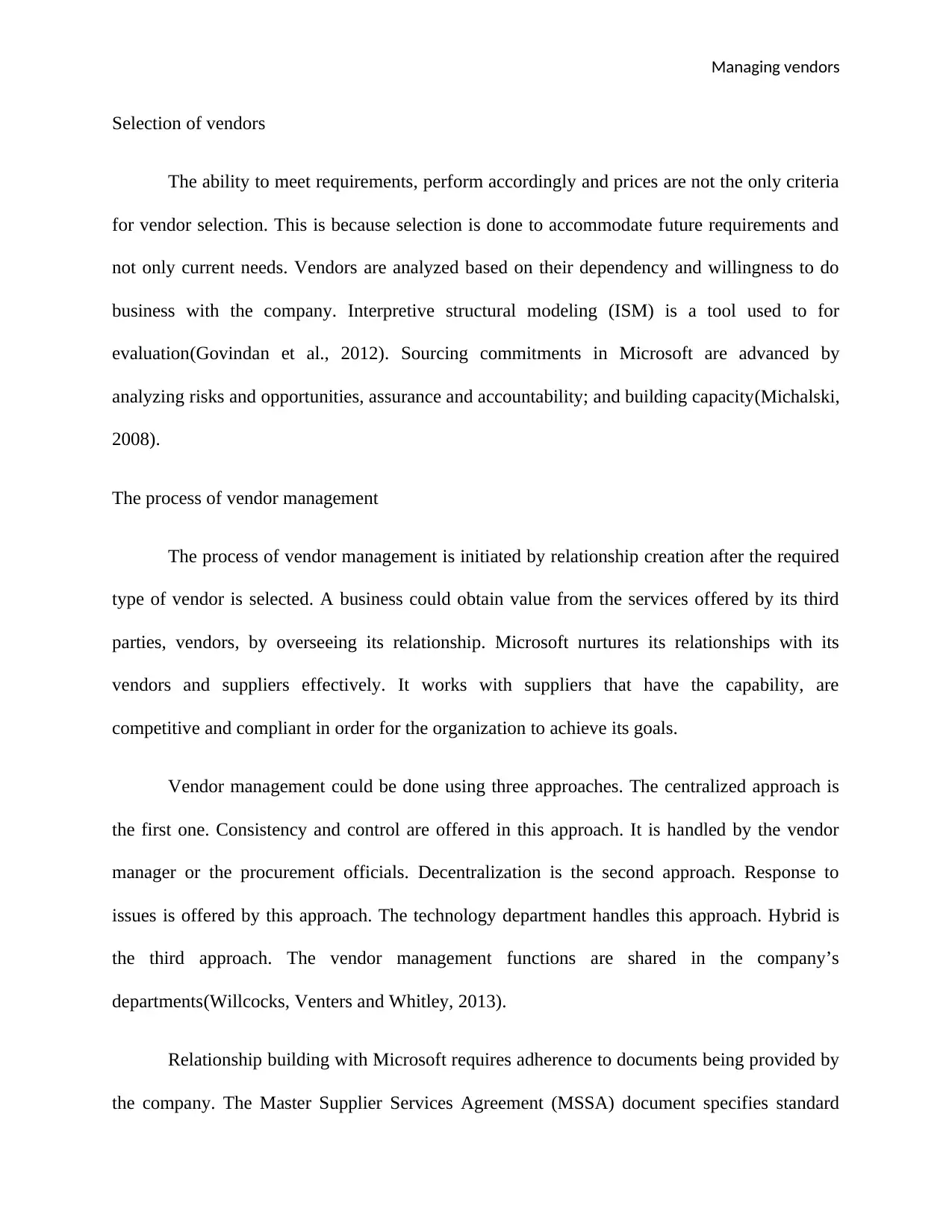
Managing vendors
Selection of vendors
The ability to meet requirements, perform accordingly and prices are not the only criteria
for vendor selection. This is because selection is done to accommodate future requirements and
not only current needs. Vendors are analyzed based on their dependency and willingness to do
business with the company. Interpretive structural modeling (ISM) is a tool used to for
evaluation(Govindan et al., 2012). Sourcing commitments in Microsoft are advanced by
analyzing risks and opportunities, assurance and accountability; and building capacity(Michalski,
2008).
The process of vendor management
The process of vendor management is initiated by relationship creation after the required
type of vendor is selected. A business could obtain value from the services offered by its third
parties, vendors, by overseeing its relationship. Microsoft nurtures its relationships with its
vendors and suppliers effectively. It works with suppliers that have the capability, are
competitive and compliant in order for the organization to achieve its goals.
Vendor management could be done using three approaches. The centralized approach is
the first one. Consistency and control are offered in this approach. It is handled by the vendor
manager or the procurement officials. Decentralization is the second approach. Response to
issues is offered by this approach. The technology department handles this approach. Hybrid is
the third approach. The vendor management functions are shared in the company’s
departments(Willcocks, Venters and Whitley, 2013).
Relationship building with Microsoft requires adherence to documents being provided by
the company. The Master Supplier Services Agreement (MSSA) document specifies standard
Selection of vendors
The ability to meet requirements, perform accordingly and prices are not the only criteria
for vendor selection. This is because selection is done to accommodate future requirements and
not only current needs. Vendors are analyzed based on their dependency and willingness to do
business with the company. Interpretive structural modeling (ISM) is a tool used to for
evaluation(Govindan et al., 2012). Sourcing commitments in Microsoft are advanced by
analyzing risks and opportunities, assurance and accountability; and building capacity(Michalski,
2008).
The process of vendor management
The process of vendor management is initiated by relationship creation after the required
type of vendor is selected. A business could obtain value from the services offered by its third
parties, vendors, by overseeing its relationship. Microsoft nurtures its relationships with its
vendors and suppliers effectively. It works with suppliers that have the capability, are
competitive and compliant in order for the organization to achieve its goals.
Vendor management could be done using three approaches. The centralized approach is
the first one. Consistency and control are offered in this approach. It is handled by the vendor
manager or the procurement officials. Decentralization is the second approach. Response to
issues is offered by this approach. The technology department handles this approach. Hybrid is
the third approach. The vendor management functions are shared in the company’s
departments(Willcocks, Venters and Whitley, 2013).
Relationship building with Microsoft requires adherence to documents being provided by
the company. The Master Supplier Services Agreement (MSSA) document specifies standard
⊘ This is a preview!⊘
Do you want full access?
Subscribe today to unlock all pages.

Trusted by 1+ million students worldwide
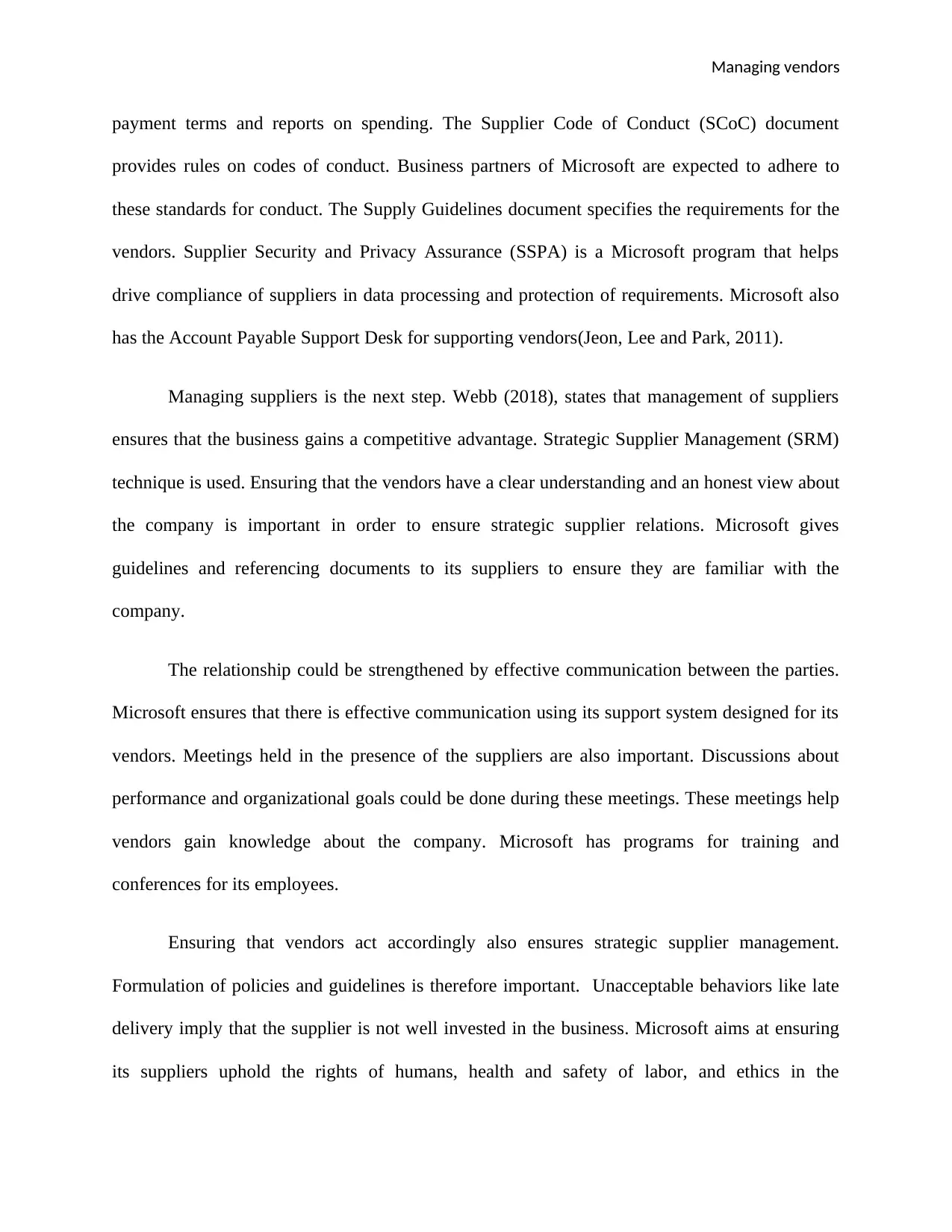
Managing vendors
payment terms and reports on spending. The Supplier Code of Conduct (SCoC) document
provides rules on codes of conduct. Business partners of Microsoft are expected to adhere to
these standards for conduct. The Supply Guidelines document specifies the requirements for the
vendors. Supplier Security and Privacy Assurance (SSPA) is a Microsoft program that helps
drive compliance of suppliers in data processing and protection of requirements. Microsoft also
has the Account Payable Support Desk for supporting vendors(Jeon, Lee and Park, 2011).
Managing suppliers is the next step. Webb (2018), states that management of suppliers
ensures that the business gains a competitive advantage. Strategic Supplier Management (SRM)
technique is used. Ensuring that the vendors have a clear understanding and an honest view about
the company is important in order to ensure strategic supplier relations. Microsoft gives
guidelines and referencing documents to its suppliers to ensure they are familiar with the
company.
The relationship could be strengthened by effective communication between the parties.
Microsoft ensures that there is effective communication using its support system designed for its
vendors. Meetings held in the presence of the suppliers are also important. Discussions about
performance and organizational goals could be done during these meetings. These meetings help
vendors gain knowledge about the company. Microsoft has programs for training and
conferences for its employees.
Ensuring that vendors act accordingly also ensures strategic supplier management.
Formulation of policies and guidelines is therefore important. Unacceptable behaviors like late
delivery imply that the supplier is not well invested in the business. Microsoft aims at ensuring
its suppliers uphold the rights of humans, health and safety of labor, and ethics in the
payment terms and reports on spending. The Supplier Code of Conduct (SCoC) document
provides rules on codes of conduct. Business partners of Microsoft are expected to adhere to
these standards for conduct. The Supply Guidelines document specifies the requirements for the
vendors. Supplier Security and Privacy Assurance (SSPA) is a Microsoft program that helps
drive compliance of suppliers in data processing and protection of requirements. Microsoft also
has the Account Payable Support Desk for supporting vendors(Jeon, Lee and Park, 2011).
Managing suppliers is the next step. Webb (2018), states that management of suppliers
ensures that the business gains a competitive advantage. Strategic Supplier Management (SRM)
technique is used. Ensuring that the vendors have a clear understanding and an honest view about
the company is important in order to ensure strategic supplier relations. Microsoft gives
guidelines and referencing documents to its suppliers to ensure they are familiar with the
company.
The relationship could be strengthened by effective communication between the parties.
Microsoft ensures that there is effective communication using its support system designed for its
vendors. Meetings held in the presence of the suppliers are also important. Discussions about
performance and organizational goals could be done during these meetings. These meetings help
vendors gain knowledge about the company. Microsoft has programs for training and
conferences for its employees.
Ensuring that vendors act accordingly also ensures strategic supplier management.
Formulation of policies and guidelines is therefore important. Unacceptable behaviors like late
delivery imply that the supplier is not well invested in the business. Microsoft aims at ensuring
its suppliers uphold the rights of humans, health and safety of labor, and ethics in the
Paraphrase This Document
Need a fresh take? Get an instant paraphrase of this document with our AI Paraphraser
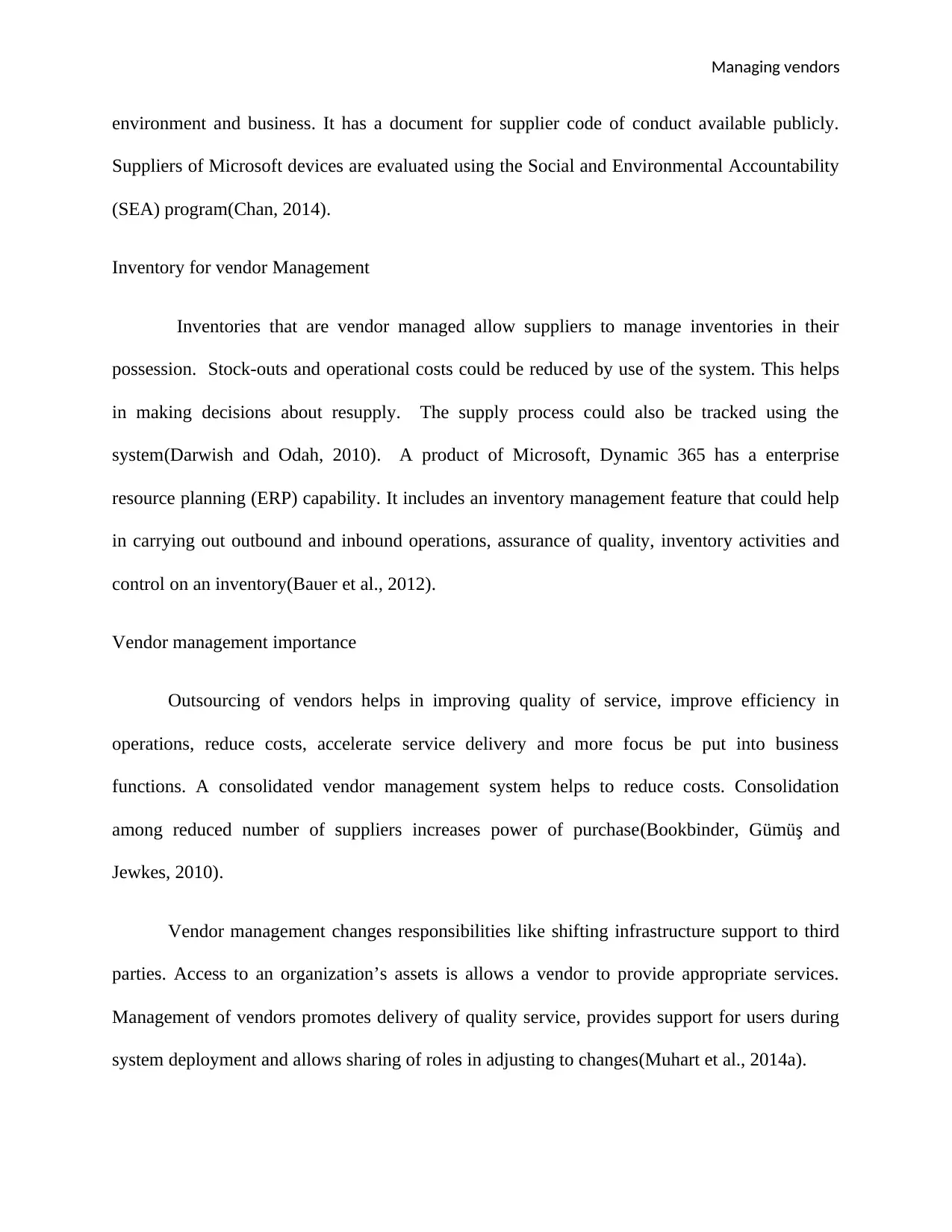
Managing vendors
environment and business. It has a document for supplier code of conduct available publicly.
Suppliers of Microsoft devices are evaluated using the Social and Environmental Accountability
(SEA) program(Chan, 2014).
Inventory for vendor Management
Inventories that are vendor managed allow suppliers to manage inventories in their
possession. Stock-outs and operational costs could be reduced by use of the system. This helps
in making decisions about resupply. The supply process could also be tracked using the
system(Darwish and Odah, 2010). A product of Microsoft, Dynamic 365 has a enterprise
resource planning (ERP) capability. It includes an inventory management feature that could help
in carrying out outbound and inbound operations, assurance of quality, inventory activities and
control on an inventory(Bauer et al., 2012).
Vendor management importance
Outsourcing of vendors helps in improving quality of service, improve efficiency in
operations, reduce costs, accelerate service delivery and more focus be put into business
functions. A consolidated vendor management system helps to reduce costs. Consolidation
among reduced number of suppliers increases power of purchase(Bookbinder, Gümüş and
Jewkes, 2010).
Vendor management changes responsibilities like shifting infrastructure support to third
parties. Access to an organization’s assets is allows a vendor to provide appropriate services.
Management of vendors promotes delivery of quality service, provides support for users during
system deployment and allows sharing of roles in adjusting to changes(Muhart et al., 2014a).
environment and business. It has a document for supplier code of conduct available publicly.
Suppliers of Microsoft devices are evaluated using the Social and Environmental Accountability
(SEA) program(Chan, 2014).
Inventory for vendor Management
Inventories that are vendor managed allow suppliers to manage inventories in their
possession. Stock-outs and operational costs could be reduced by use of the system. This helps
in making decisions about resupply. The supply process could also be tracked using the
system(Darwish and Odah, 2010). A product of Microsoft, Dynamic 365 has a enterprise
resource planning (ERP) capability. It includes an inventory management feature that could help
in carrying out outbound and inbound operations, assurance of quality, inventory activities and
control on an inventory(Bauer et al., 2012).
Vendor management importance
Outsourcing of vendors helps in improving quality of service, improve efficiency in
operations, reduce costs, accelerate service delivery and more focus be put into business
functions. A consolidated vendor management system helps to reduce costs. Consolidation
among reduced number of suppliers increases power of purchase(Bookbinder, Gümüş and
Jewkes, 2010).
Vendor management changes responsibilities like shifting infrastructure support to third
parties. Access to an organization’s assets is allows a vendor to provide appropriate services.
Management of vendors promotes delivery of quality service, provides support for users during
system deployment and allows sharing of roles in adjusting to changes(Muhart et al., 2014a).
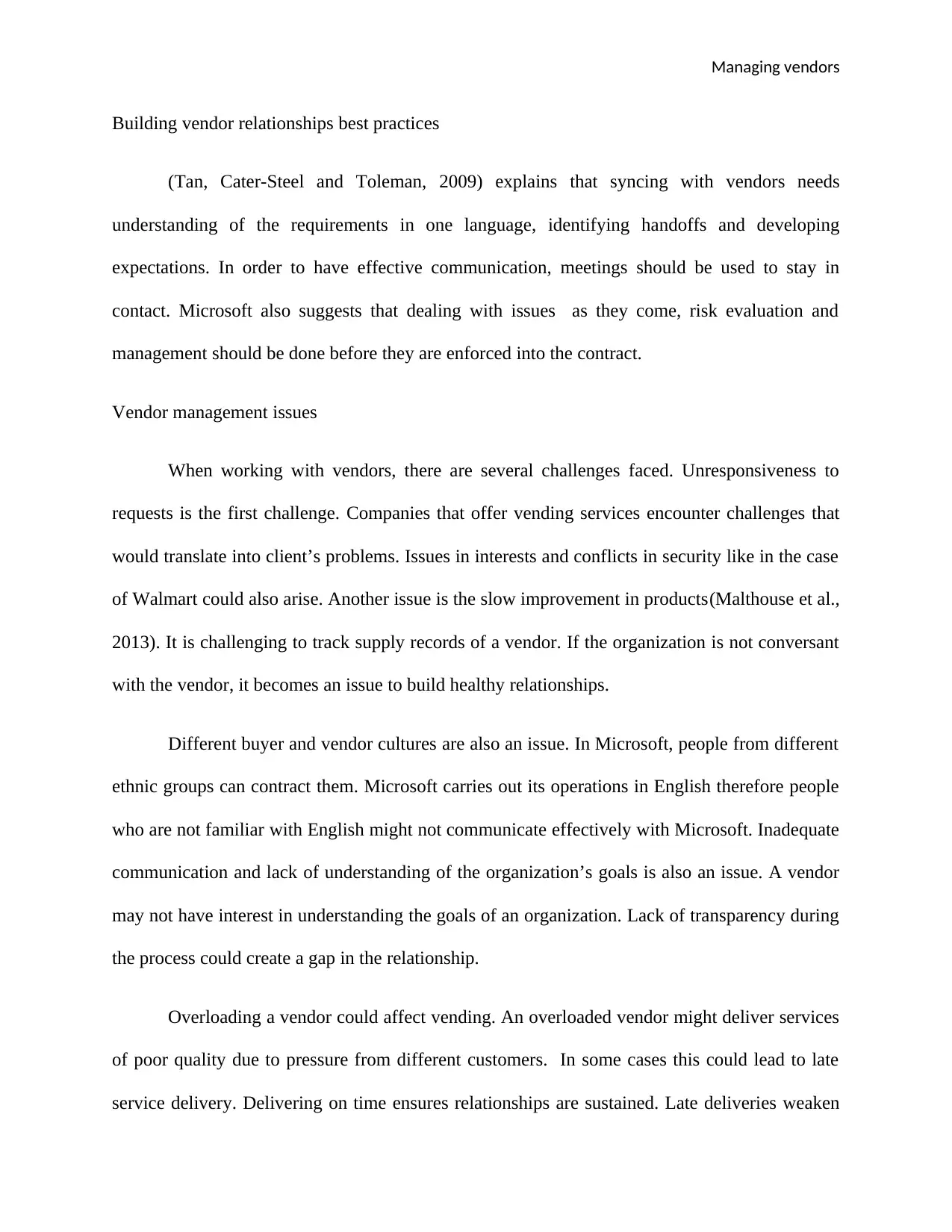
Managing vendors
Building vendor relationships best practices
(Tan, Cater-Steel and Toleman, 2009) explains that syncing with vendors needs
understanding of the requirements in one language, identifying handoffs and developing
expectations. In order to have effective communication, meetings should be used to stay in
contact. Microsoft also suggests that dealing with issues as they come, risk evaluation and
management should be done before they are enforced into the contract.
Vendor management issues
When working with vendors, there are several challenges faced. Unresponsiveness to
requests is the first challenge. Companies that offer vending services encounter challenges that
would translate into client’s problems. Issues in interests and conflicts in security like in the case
of Walmart could also arise. Another issue is the slow improvement in products(Malthouse et al.,
2013). It is challenging to track supply records of a vendor. If the organization is not conversant
with the vendor, it becomes an issue to build healthy relationships.
Different buyer and vendor cultures are also an issue. In Microsoft, people from different
ethnic groups can contract them. Microsoft carries out its operations in English therefore people
who are not familiar with English might not communicate effectively with Microsoft. Inadequate
communication and lack of understanding of the organization’s goals is also an issue. A vendor
may not have interest in understanding the goals of an organization. Lack of transparency during
the process could create a gap in the relationship.
Overloading a vendor could affect vending. An overloaded vendor might deliver services
of poor quality due to pressure from different customers. In some cases this could lead to late
service delivery. Delivering on time ensures relationships are sustained. Late deliveries weaken
Building vendor relationships best practices
(Tan, Cater-Steel and Toleman, 2009) explains that syncing with vendors needs
understanding of the requirements in one language, identifying handoffs and developing
expectations. In order to have effective communication, meetings should be used to stay in
contact. Microsoft also suggests that dealing with issues as they come, risk evaluation and
management should be done before they are enforced into the contract.
Vendor management issues
When working with vendors, there are several challenges faced. Unresponsiveness to
requests is the first challenge. Companies that offer vending services encounter challenges that
would translate into client’s problems. Issues in interests and conflicts in security like in the case
of Walmart could also arise. Another issue is the slow improvement in products(Malthouse et al.,
2013). It is challenging to track supply records of a vendor. If the organization is not conversant
with the vendor, it becomes an issue to build healthy relationships.
Different buyer and vendor cultures are also an issue. In Microsoft, people from different
ethnic groups can contract them. Microsoft carries out its operations in English therefore people
who are not familiar with English might not communicate effectively with Microsoft. Inadequate
communication and lack of understanding of the organization’s goals is also an issue. A vendor
may not have interest in understanding the goals of an organization. Lack of transparency during
the process could create a gap in the relationship.
Overloading a vendor could affect vending. An overloaded vendor might deliver services
of poor quality due to pressure from different customers. In some cases this could lead to late
service delivery. Delivering on time ensures relationships are sustained. Late deliveries weaken
⊘ This is a preview!⊘
Do you want full access?
Subscribe today to unlock all pages.

Trusted by 1+ million students worldwide
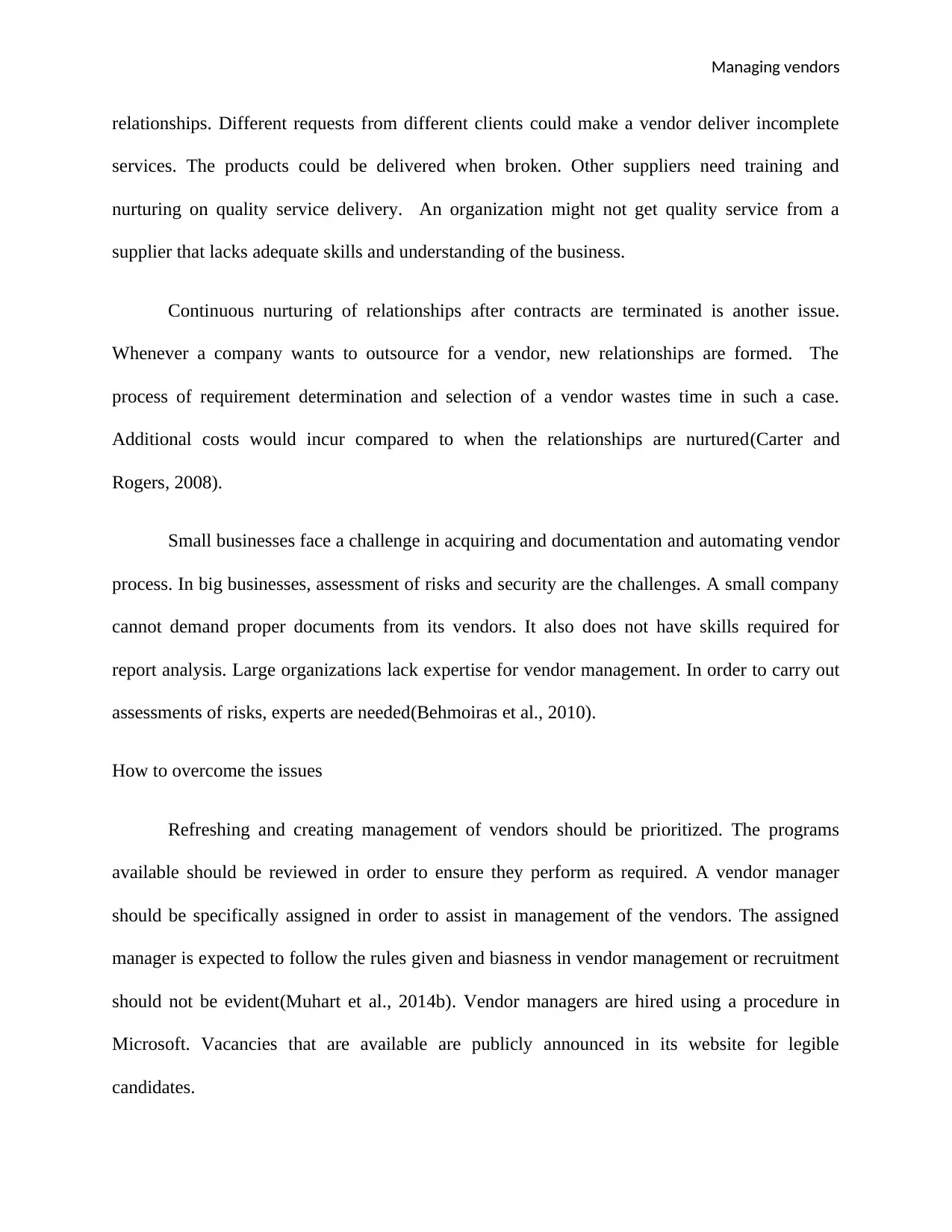
Managing vendors
relationships. Different requests from different clients could make a vendor deliver incomplete
services. The products could be delivered when broken. Other suppliers need training and
nurturing on quality service delivery. An organization might not get quality service from a
supplier that lacks adequate skills and understanding of the business.
Continuous nurturing of relationships after contracts are terminated is another issue.
Whenever a company wants to outsource for a vendor, new relationships are formed. The
process of requirement determination and selection of a vendor wastes time in such a case.
Additional costs would incur compared to when the relationships are nurtured(Carter and
Rogers, 2008).
Small businesses face a challenge in acquiring and documentation and automating vendor
process. In big businesses, assessment of risks and security are the challenges. A small company
cannot demand proper documents from its vendors. It also does not have skills required for
report analysis. Large organizations lack expertise for vendor management. In order to carry out
assessments of risks, experts are needed(Behmoiras et al., 2010).
How to overcome the issues
Refreshing and creating management of vendors should be prioritized. The programs
available should be reviewed in order to ensure they perform as required. A vendor manager
should be specifically assigned in order to assist in management of the vendors. The assigned
manager is expected to follow the rules given and biasness in vendor management or recruitment
should not be evident(Muhart et al., 2014b). Vendor managers are hired using a procedure in
Microsoft. Vacancies that are available are publicly announced in its website for legible
candidates.
relationships. Different requests from different clients could make a vendor deliver incomplete
services. The products could be delivered when broken. Other suppliers need training and
nurturing on quality service delivery. An organization might not get quality service from a
supplier that lacks adequate skills and understanding of the business.
Continuous nurturing of relationships after contracts are terminated is another issue.
Whenever a company wants to outsource for a vendor, new relationships are formed. The
process of requirement determination and selection of a vendor wastes time in such a case.
Additional costs would incur compared to when the relationships are nurtured(Carter and
Rogers, 2008).
Small businesses face a challenge in acquiring and documentation and automating vendor
process. In big businesses, assessment of risks and security are the challenges. A small company
cannot demand proper documents from its vendors. It also does not have skills required for
report analysis. Large organizations lack expertise for vendor management. In order to carry out
assessments of risks, experts are needed(Behmoiras et al., 2010).
How to overcome the issues
Refreshing and creating management of vendors should be prioritized. The programs
available should be reviewed in order to ensure they perform as required. A vendor manager
should be specifically assigned in order to assist in management of the vendors. The assigned
manager is expected to follow the rules given and biasness in vendor management or recruitment
should not be evident(Muhart et al., 2014b). Vendor managers are hired using a procedure in
Microsoft. Vacancies that are available are publicly announced in its website for legible
candidates.
Paraphrase This Document
Need a fresh take? Get an instant paraphrase of this document with our AI Paraphraser
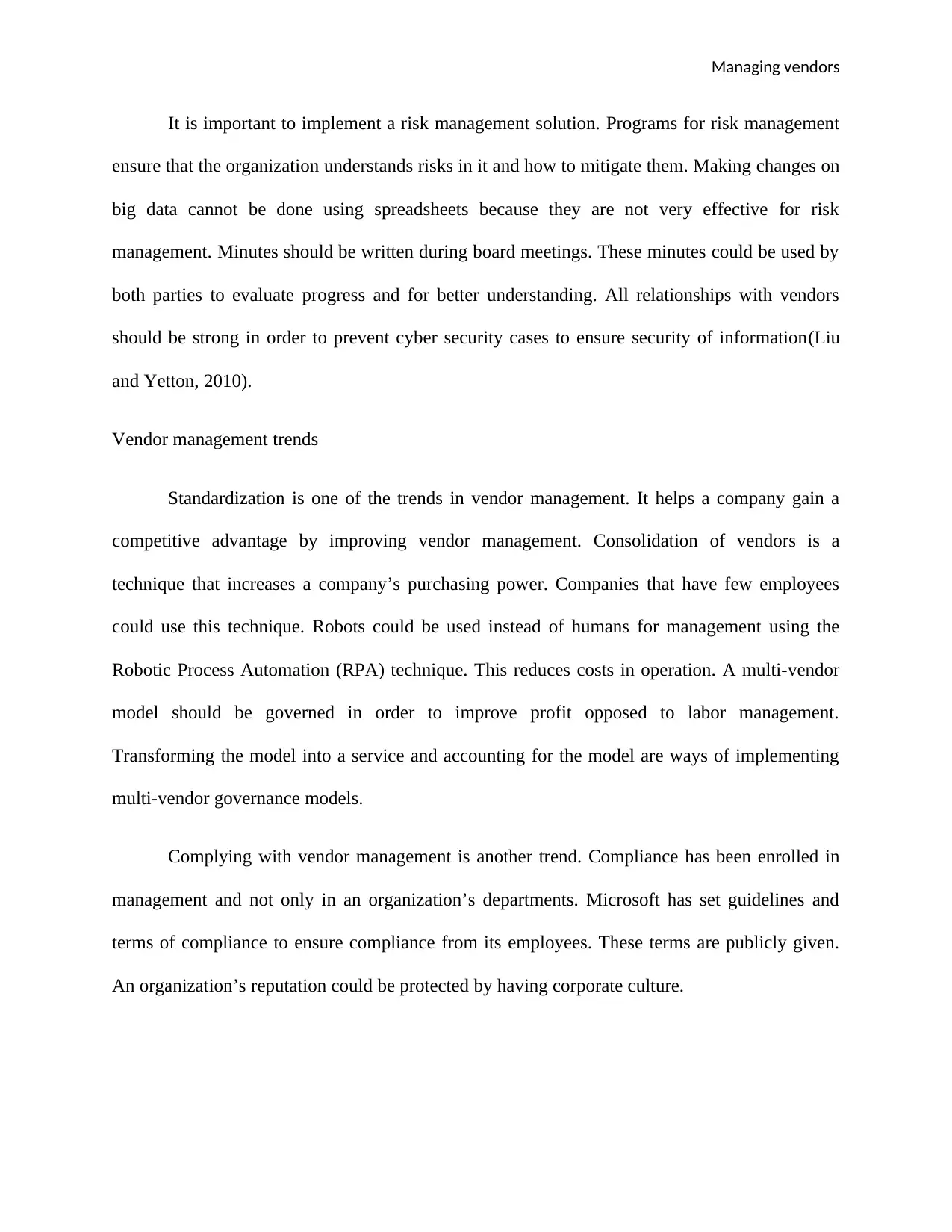
Managing vendors
It is important to implement a risk management solution. Programs for risk management
ensure that the organization understands risks in it and how to mitigate them. Making changes on
big data cannot be done using spreadsheets because they are not very effective for risk
management. Minutes should be written during board meetings. These minutes could be used by
both parties to evaluate progress and for better understanding. All relationships with vendors
should be strong in order to prevent cyber security cases to ensure security of information(Liu
and Yetton, 2010).
Vendor management trends
Standardization is one of the trends in vendor management. It helps a company gain a
competitive advantage by improving vendor management. Consolidation of vendors is a
technique that increases a company’s purchasing power. Companies that have few employees
could use this technique. Robots could be used instead of humans for management using the
Robotic Process Automation (RPA) technique. This reduces costs in operation. A multi-vendor
model should be governed in order to improve profit opposed to labor management.
Transforming the model into a service and accounting for the model are ways of implementing
multi-vendor governance models.
Complying with vendor management is another trend. Compliance has been enrolled in
management and not only in an organization’s departments. Microsoft has set guidelines and
terms of compliance to ensure compliance from its employees. These terms are publicly given.
An organization’s reputation could be protected by having corporate culture.
It is important to implement a risk management solution. Programs for risk management
ensure that the organization understands risks in it and how to mitigate them. Making changes on
big data cannot be done using spreadsheets because they are not very effective for risk
management. Minutes should be written during board meetings. These minutes could be used by
both parties to evaluate progress and for better understanding. All relationships with vendors
should be strong in order to prevent cyber security cases to ensure security of information(Liu
and Yetton, 2010).
Vendor management trends
Standardization is one of the trends in vendor management. It helps a company gain a
competitive advantage by improving vendor management. Consolidation of vendors is a
technique that increases a company’s purchasing power. Companies that have few employees
could use this technique. Robots could be used instead of humans for management using the
Robotic Process Automation (RPA) technique. This reduces costs in operation. A multi-vendor
model should be governed in order to improve profit opposed to labor management.
Transforming the model into a service and accounting for the model are ways of implementing
multi-vendor governance models.
Complying with vendor management is another trend. Compliance has been enrolled in
management and not only in an organization’s departments. Microsoft has set guidelines and
terms of compliance to ensure compliance from its employees. These terms are publicly given.
An organization’s reputation could be protected by having corporate culture.
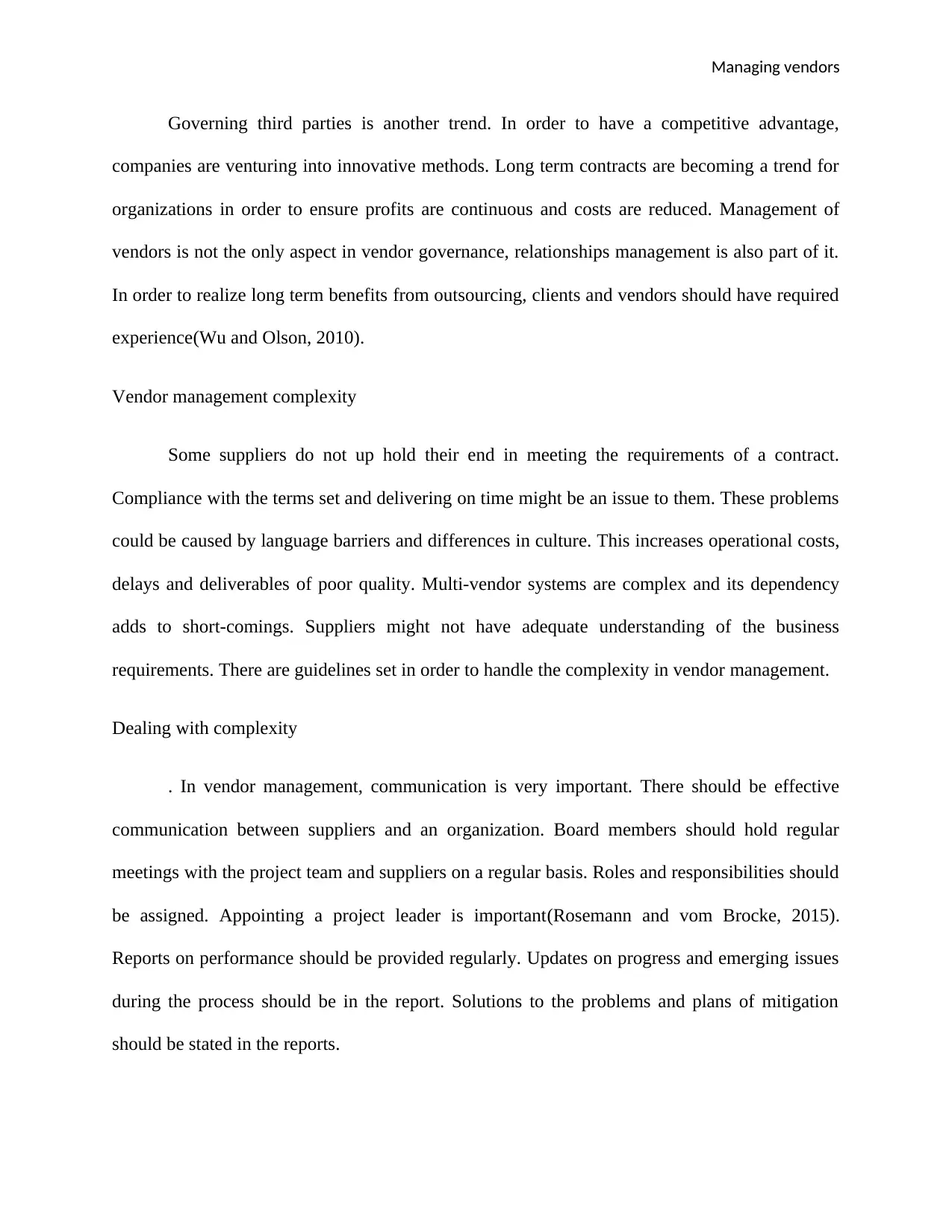
Managing vendors
Governing third parties is another trend. In order to have a competitive advantage,
companies are venturing into innovative methods. Long term contracts are becoming a trend for
organizations in order to ensure profits are continuous and costs are reduced. Management of
vendors is not the only aspect in vendor governance, relationships management is also part of it.
In order to realize long term benefits from outsourcing, clients and vendors should have required
experience(Wu and Olson, 2010).
Vendor management complexity
Some suppliers do not up hold their end in meeting the requirements of a contract.
Compliance with the terms set and delivering on time might be an issue to them. These problems
could be caused by language barriers and differences in culture. This increases operational costs,
delays and deliverables of poor quality. Multi-vendor systems are complex and its dependency
adds to short-comings. Suppliers might not have adequate understanding of the business
requirements. There are guidelines set in order to handle the complexity in vendor management.
Dealing with complexity
. In vendor management, communication is very important. There should be effective
communication between suppliers and an organization. Board members should hold regular
meetings with the project team and suppliers on a regular basis. Roles and responsibilities should
be assigned. Appointing a project leader is important(Rosemann and vom Brocke, 2015).
Reports on performance should be provided regularly. Updates on progress and emerging issues
during the process should be in the report. Solutions to the problems and plans of mitigation
should be stated in the reports.
Governing third parties is another trend. In order to have a competitive advantage,
companies are venturing into innovative methods. Long term contracts are becoming a trend for
organizations in order to ensure profits are continuous and costs are reduced. Management of
vendors is not the only aspect in vendor governance, relationships management is also part of it.
In order to realize long term benefits from outsourcing, clients and vendors should have required
experience(Wu and Olson, 2010).
Vendor management complexity
Some suppliers do not up hold their end in meeting the requirements of a contract.
Compliance with the terms set and delivering on time might be an issue to them. These problems
could be caused by language barriers and differences in culture. This increases operational costs,
delays and deliverables of poor quality. Multi-vendor systems are complex and its dependency
adds to short-comings. Suppliers might not have adequate understanding of the business
requirements. There are guidelines set in order to handle the complexity in vendor management.
Dealing with complexity
. In vendor management, communication is very important. There should be effective
communication between suppliers and an organization. Board members should hold regular
meetings with the project team and suppliers on a regular basis. Roles and responsibilities should
be assigned. Appointing a project leader is important(Rosemann and vom Brocke, 2015).
Reports on performance should be provided regularly. Updates on progress and emerging issues
during the process should be in the report. Solutions to the problems and plans of mitigation
should be stated in the reports.
⊘ This is a preview!⊘
Do you want full access?
Subscribe today to unlock all pages.

Trusted by 1+ million students worldwide
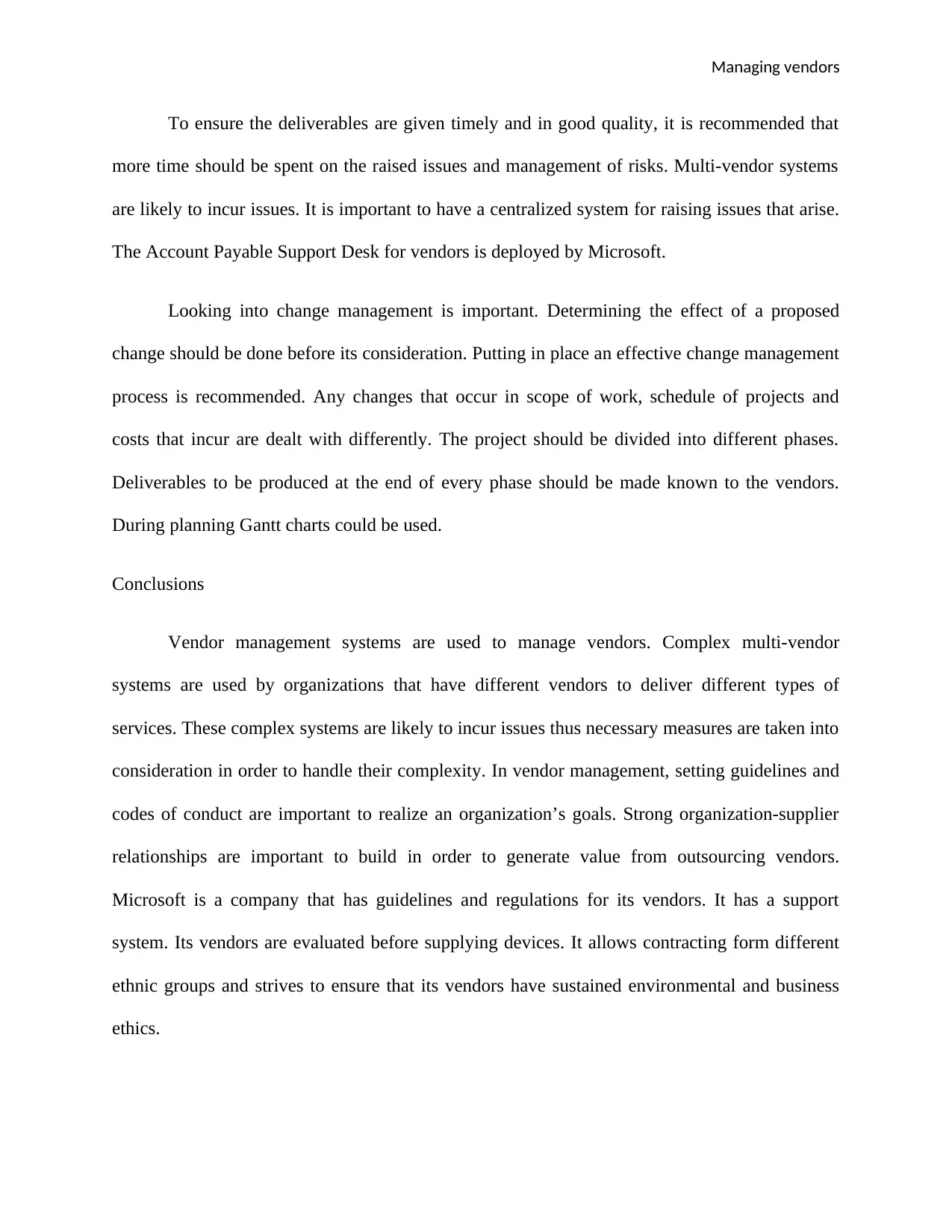
Managing vendors
To ensure the deliverables are given timely and in good quality, it is recommended that
more time should be spent on the raised issues and management of risks. Multi-vendor systems
are likely to incur issues. It is important to have a centralized system for raising issues that arise.
The Account Payable Support Desk for vendors is deployed by Microsoft.
Looking into change management is important. Determining the effect of a proposed
change should be done before its consideration. Putting in place an effective change management
process is recommended. Any changes that occur in scope of work, schedule of projects and
costs that incur are dealt with differently. The project should be divided into different phases.
Deliverables to be produced at the end of every phase should be made known to the vendors.
During planning Gantt charts could be used.
Conclusions
Vendor management systems are used to manage vendors. Complex multi-vendor
systems are used by organizations that have different vendors to deliver different types of
services. These complex systems are likely to incur issues thus necessary measures are taken into
consideration in order to handle their complexity. In vendor management, setting guidelines and
codes of conduct are important to realize an organization’s goals. Strong organization-supplier
relationships are important to build in order to generate value from outsourcing vendors.
Microsoft is a company that has guidelines and regulations for its vendors. It has a support
system. Its vendors are evaluated before supplying devices. It allows contracting form different
ethnic groups and strives to ensure that its vendors have sustained environmental and business
ethics.
To ensure the deliverables are given timely and in good quality, it is recommended that
more time should be spent on the raised issues and management of risks. Multi-vendor systems
are likely to incur issues. It is important to have a centralized system for raising issues that arise.
The Account Payable Support Desk for vendors is deployed by Microsoft.
Looking into change management is important. Determining the effect of a proposed
change should be done before its consideration. Putting in place an effective change management
process is recommended. Any changes that occur in scope of work, schedule of projects and
costs that incur are dealt with differently. The project should be divided into different phases.
Deliverables to be produced at the end of every phase should be made known to the vendors.
During planning Gantt charts could be used.
Conclusions
Vendor management systems are used to manage vendors. Complex multi-vendor
systems are used by organizations that have different vendors to deliver different types of
services. These complex systems are likely to incur issues thus necessary measures are taken into
consideration in order to handle their complexity. In vendor management, setting guidelines and
codes of conduct are important to realize an organization’s goals. Strong organization-supplier
relationships are important to build in order to generate value from outsourcing vendors.
Microsoft is a company that has guidelines and regulations for its vendors. It has a support
system. Its vendors are evaluated before supplying devices. It allows contracting form different
ethnic groups and strives to ensure that its vendors have sustained environmental and business
ethics.
Paraphrase This Document
Need a fresh take? Get an instant paraphrase of this document with our AI Paraphraser
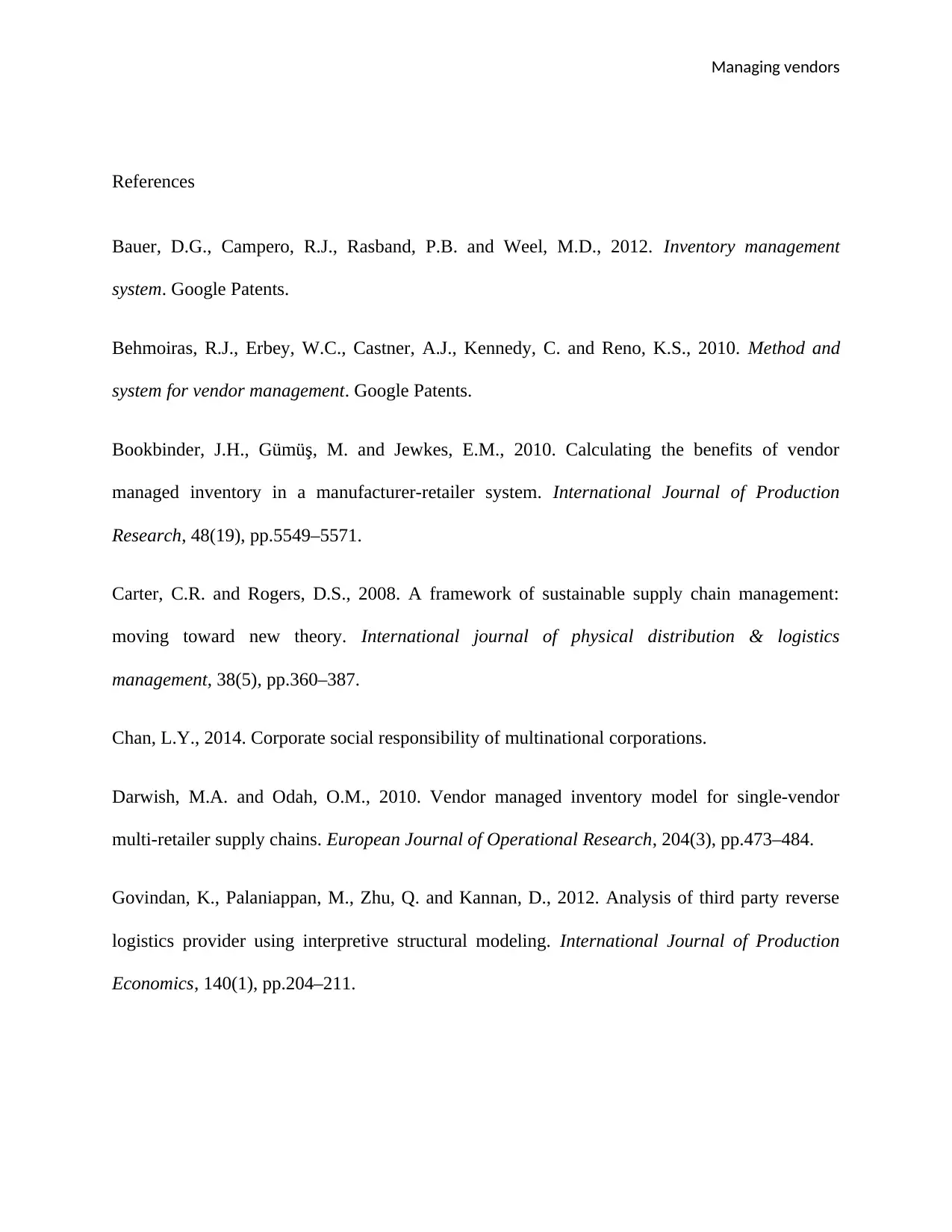
Managing vendors
References
Bauer, D.G., Campero, R.J., Rasband, P.B. and Weel, M.D., 2012. Inventory management
system. Google Patents.
Behmoiras, R.J., Erbey, W.C., Castner, A.J., Kennedy, C. and Reno, K.S., 2010. Method and
system for vendor management. Google Patents.
Bookbinder, J.H., Gümüş, M. and Jewkes, E.M., 2010. Calculating the benefits of vendor
managed inventory in a manufacturer-retailer system. International Journal of Production
Research, 48(19), pp.5549–5571.
Carter, C.R. and Rogers, D.S., 2008. A framework of sustainable supply chain management:
moving toward new theory. International journal of physical distribution & logistics
management, 38(5), pp.360–387.
Chan, L.Y., 2014. Corporate social responsibility of multinational corporations.
Darwish, M.A. and Odah, O.M., 2010. Vendor managed inventory model for single-vendor
multi-retailer supply chains. European Journal of Operational Research, 204(3), pp.473–484.
Govindan, K., Palaniappan, M., Zhu, Q. and Kannan, D., 2012. Analysis of third party reverse
logistics provider using interpretive structural modeling. International Journal of Production
Economics, 140(1), pp.204–211.
References
Bauer, D.G., Campero, R.J., Rasband, P.B. and Weel, M.D., 2012. Inventory management
system. Google Patents.
Behmoiras, R.J., Erbey, W.C., Castner, A.J., Kennedy, C. and Reno, K.S., 2010. Method and
system for vendor management. Google Patents.
Bookbinder, J.H., Gümüş, M. and Jewkes, E.M., 2010. Calculating the benefits of vendor
managed inventory in a manufacturer-retailer system. International Journal of Production
Research, 48(19), pp.5549–5571.
Carter, C.R. and Rogers, D.S., 2008. A framework of sustainable supply chain management:
moving toward new theory. International journal of physical distribution & logistics
management, 38(5), pp.360–387.
Chan, L.Y., 2014. Corporate social responsibility of multinational corporations.
Darwish, M.A. and Odah, O.M., 2010. Vendor managed inventory model for single-vendor
multi-retailer supply chains. European Journal of Operational Research, 204(3), pp.473–484.
Govindan, K., Palaniappan, M., Zhu, Q. and Kannan, D., 2012. Analysis of third party reverse
logistics provider using interpretive structural modeling. International Journal of Production
Economics, 140(1), pp.204–211.
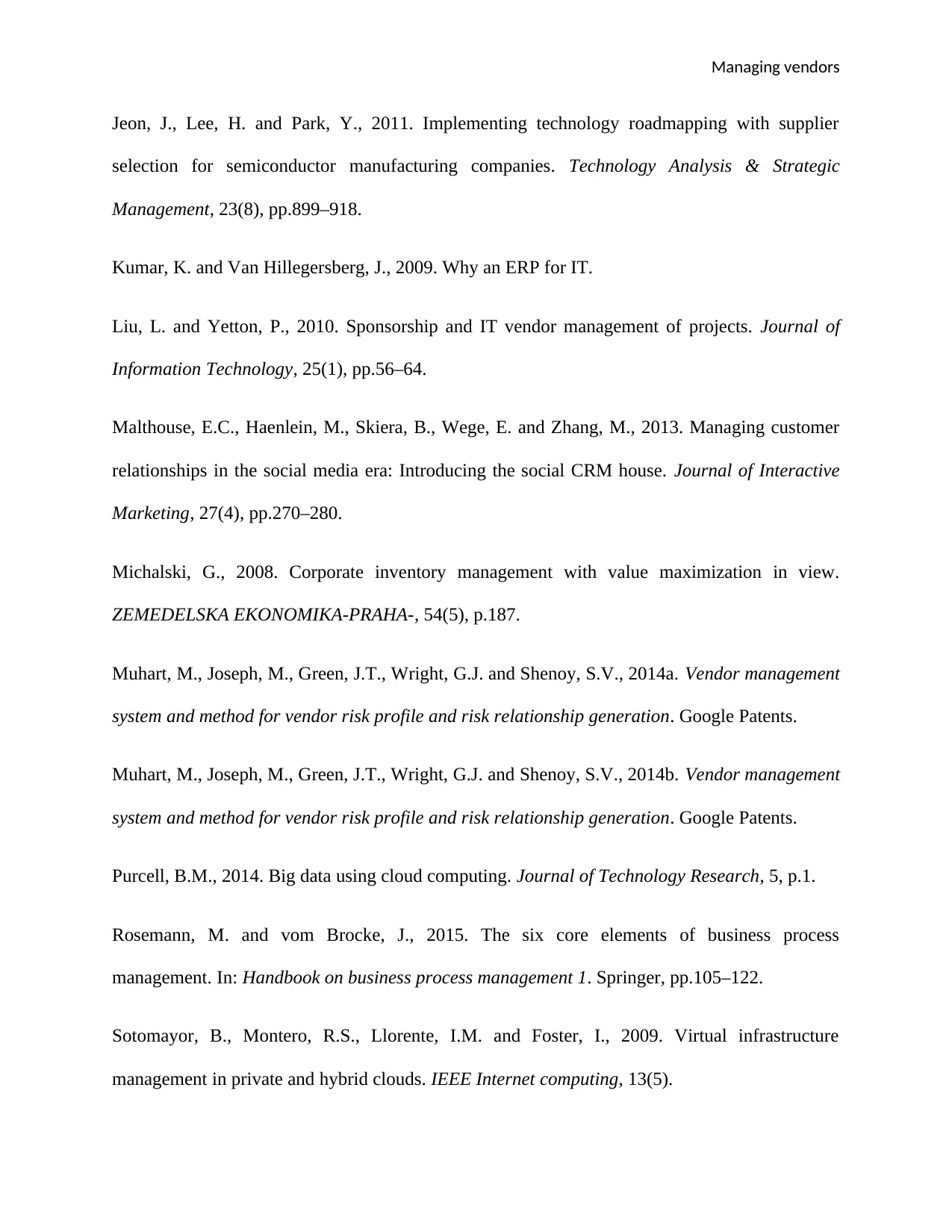
Managing vendors
Jeon, J., Lee, H. and Park, Y., 2011. Implementing technology roadmapping with supplier
selection for semiconductor manufacturing companies. Technology Analysis & Strategic
Management, 23(8), pp.899–918.
Kumar, K. and Van Hillegersberg, J., 2009. Why an ERP for IT.
Liu, L. and Yetton, P., 2010. Sponsorship and IT vendor management of projects. Journal of
Information Technology, 25(1), pp.56–64.
Malthouse, E.C., Haenlein, M., Skiera, B., Wege, E. and Zhang, M., 2013. Managing customer
relationships in the social media era: Introducing the social CRM house. Journal of Interactive
Marketing, 27(4), pp.270–280.
Michalski, G., 2008. Corporate inventory management with value maximization in view.
ZEMEDELSKA EKONOMIKA-PRAHA-, 54(5), p.187.
Muhart, M., Joseph, M., Green, J.T., Wright, G.J. and Shenoy, S.V., 2014a. Vendor management
system and method for vendor risk profile and risk relationship generation. Google Patents.
Muhart, M., Joseph, M., Green, J.T., Wright, G.J. and Shenoy, S.V., 2014b. Vendor management
system and method for vendor risk profile and risk relationship generation. Google Patents.
Purcell, B.M., 2014. Big data using cloud computing. Journal of Technology Research, 5, p.1.
Rosemann, M. and vom Brocke, J., 2015. The six core elements of business process
management. In: Handbook on business process management 1. Springer, pp.105–122.
Sotomayor, B., Montero, R.S., Llorente, I.M. and Foster, I., 2009. Virtual infrastructure
management in private and hybrid clouds. IEEE Internet computing, 13(5).
Jeon, J., Lee, H. and Park, Y., 2011. Implementing technology roadmapping with supplier
selection for semiconductor manufacturing companies. Technology Analysis & Strategic
Management, 23(8), pp.899–918.
Kumar, K. and Van Hillegersberg, J., 2009. Why an ERP for IT.
Liu, L. and Yetton, P., 2010. Sponsorship and IT vendor management of projects. Journal of
Information Technology, 25(1), pp.56–64.
Malthouse, E.C., Haenlein, M., Skiera, B., Wege, E. and Zhang, M., 2013. Managing customer
relationships in the social media era: Introducing the social CRM house. Journal of Interactive
Marketing, 27(4), pp.270–280.
Michalski, G., 2008. Corporate inventory management with value maximization in view.
ZEMEDELSKA EKONOMIKA-PRAHA-, 54(5), p.187.
Muhart, M., Joseph, M., Green, J.T., Wright, G.J. and Shenoy, S.V., 2014a. Vendor management
system and method for vendor risk profile and risk relationship generation. Google Patents.
Muhart, M., Joseph, M., Green, J.T., Wright, G.J. and Shenoy, S.V., 2014b. Vendor management
system and method for vendor risk profile and risk relationship generation. Google Patents.
Purcell, B.M., 2014. Big data using cloud computing. Journal of Technology Research, 5, p.1.
Rosemann, M. and vom Brocke, J., 2015. The six core elements of business process
management. In: Handbook on business process management 1. Springer, pp.105–122.
Sotomayor, B., Montero, R.S., Llorente, I.M. and Foster, I., 2009. Virtual infrastructure
management in private and hybrid clouds. IEEE Internet computing, 13(5).
⊘ This is a preview!⊘
Do you want full access?
Subscribe today to unlock all pages.

Trusted by 1+ million students worldwide
1 out of 13
Related Documents
Your All-in-One AI-Powered Toolkit for Academic Success.
+13062052269
info@desklib.com
Available 24*7 on WhatsApp / Email
![[object Object]](/_next/static/media/star-bottom.7253800d.svg)
Unlock your academic potential
Copyright © 2020–2025 A2Z Services. All Rights Reserved. Developed and managed by ZUCOL.




